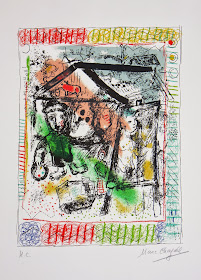Art collectors often ask our gallery about this topic, so today we are going to shed some light on the differences between different proofs and the printed edition.
What is a Limited Edition?
 |
| Marc Chagall "L'Arbre Fleuri I" - Lithograph - Edition of 100 |
When an artist prints a limited edition original print, such as a: lithograph, etching, aquatint, carborundum, screenprint, linocut, or woodcut, a set number of identical prints are made. This set number is the "Edition Size," and these will generally be numbered sequentially and hand-signed by the artist. An edition size can vary from extremely small editions of 5 to large editions of 1,000 or more. Open editions have an unknown or unlimited quantity of prints.
 |
| Joan Miro "La Magie Quotidienne" - Etching - Edition of XV on Japon |
Sometimes there are different editions printed on different kinds of paper. As an example there may be a regular edition on Arches paper with a limit of 100. These 100 prints are signed and numbered sequentially from 1/100 to 100/100. In addition to this edition on Arches paper, a smaller edition of 15 are printed on Japon paper and numbered sequentially in roman numerals from I/XV to XV/XV and signed by the artist. This brings our total edition, to 115 prints + any additional proofs that may exist.
So What is a Proof?
A proof is usually an identical print to the regular edition, that is printed at the same time - but is not part of the numbered sequence. This is known as a "Proof Aside from the Edition," and these may or may not be hand-signed by the artist. In general with any edition printed there can be anywhere from 5-50 extra proofs aside from the edition.
 |
| Pablo Picasso "Farol (B. 945)" - Linocut - Epreuve d'artiste |
Often these extra proofs are retained for the artist, otherwise known as an "Artist Proof". An artist proof can be annotated "A.P." for Artist Proof, or "E.A." in French "Epreuve d'artiste". Sometimes artists can additionally dedicate and gift a proof to a friend, collaborator, dealer, printer, or even family member.
 |
| Zao Wou-ki "En Attendant un Jour de Fete (250b)" - Etching - BAT with notes |
 |
| Sam Francis "Untitled I (TP)" - Etching - Color Trial Proof |
 |
| Marc Chagall "Le Peintre devant le Village II" - Lithograph - HC aside from edition |
The last form of a "Proof" is the "H.C." which stands for the French term "Hors Commerce" or "Not for Sale". These are exactly as they sound, identical proofs to the regular edition that are not intended to be sold. Prints designated H.C. are often given to the project collaborators as a form of appreciation or partial payment.
Total Tirage
 |
| Marc Chagall Catalogue Raisonne Description |
"Tirage", the French term meaning "output," is the total number of prints printed for an edition, including any proofs, APs, PPs, HC, and TPs. It is important to note that not every limited edition includes all of these, and the complete number of prints within a tirage are usually described in the artist's Catalogue Raisonné. Some artists and editions are catalogued very well and include full descriptions of the tirage, while others may have basic information only about the numbered edition.
For more information about printmaking and collecting original prints please visit our website:





,_Sagrada_Familia_con_%C3%A1ngel_m%C3%BAsico,_Santa_Catalina_de_Alejandr%C3%ADa,_Santa_B%C3%A1rbara,_1510-1520,_Museo_del_Prado,_M.jpg)





